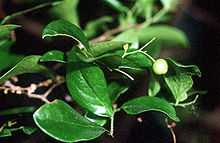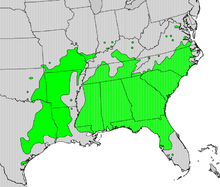Vaccinium arboreum
| Vaccinium arboreum | |
|---|---|
 | |
| Leaves and immature fruit | |
| Scientific classification | |
| Kingdom: | Plantae |
| (unranked): | Angiosperms |
| (unranked): | Eudicots |
| (unranked): | Asterids |
| Order: | Ericales |
| Family: | Ericaceae |
| Genus: | Vaccinium |
| Species: | V. arboreum |
| Binomial name | |
| Vaccinium arboreum Marshall | |
Vaccinium arboreum (Sparkleberry or Farkleberry) is a species of Vaccinium native to the southeastern United States, from southern Virginia west to southeastern Nebraska, south to Florida and eastern Texas, and north to Illinois.[1]
Description
Vaccinium arboreum [ar-bor-E-um] is a shrub (rarely a small tree) growing to 3–5 m (rarely 9 m) tall. The leaves are evergreen in the south of the range, but deciduous further north where winters are colder; they are oval-elliptic with an acute apex, 3–7 cm long and 2–4 cm broad, with a smooth or very finely toothed margin. Sparkleberry grows on sand dunes, hammocks, dry hillsides, meadows, and in rocky woods. It also grows on a variety of moist sites such as wet bottomlands and along creek banks.
The flowers are white, bell-shaped, and 3–4 mm in diameter with a five-lobed corolla, produced in racemes up to 5 cm long. The fruit is a round dry berry about 6 mm in diameter, green at first, black when ripe, edible but bitter and tough.

References
- ↑ USDA; Native Distribution - V. arboreum . accessed 11.10.2010
- Germplasm Resources Information Network: Vaccinium arboreum
- Missouriplants: Vaccinium arboreum
- Virginia Tech Dendrology: Vaccinium arboreum